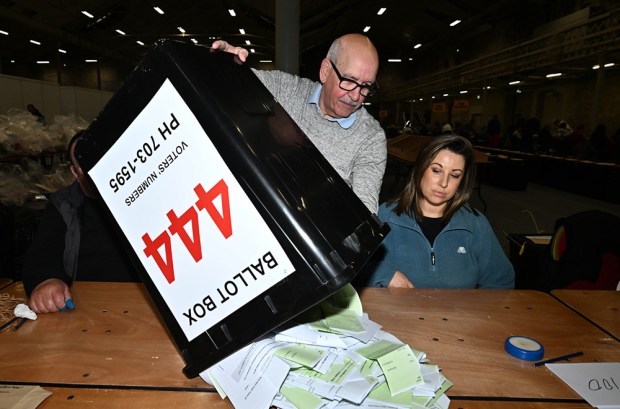It has long been the standard fare of green evangelists to prosecute their cause with persuasion by emotion rather than sticking to the facts at hand. Labor’s recent decision to opt for a 50 per cent renewable energy target by 2030 without undertaking any economic modelling is a case in point. The arguments in favour of renewable energy are well rehearsed and morally compelling. Renewable energy is not just necessary to abate dangerous carbon emissions that threaten the planet with extinction. Australia would be crazy not to reap the benefits of what promises to be one of the world’s major growth industries of tomorrow.
As appealing as this may sound, a cursory glance at the economic implications of a government imposed renewable energy minimum should be enough to dampen the enthusiasm of even the most zealous green-eyed apostles. Thankfully, a few boffins outside the Labor party hive mind have crunched the numbers: building enough solar and wind power to meet Labor’s target would cost $80 -100 billion.
To give this figure some context, it equates to any one of the following: three NBNs, four NDISs or forty eight years worth of Gonski funding. No wonder numbers are seldom mentioned in sermons about the virtues of wind power. Once they are, a government mandated renewable energy revolution starts to look more like a fiscal suicide note. Given that wind energy is currently more than twice as costly as coal and solar double again, this news should not be all that surprising. So who’ll pay the price of making Labor’s green energy utopia a reality?
Because of increased energy supply brought on by new wind turbines and large-scale solar, the cost will initially be reflected in government expenditure rather than the electricity bills of consumers. People will pay through higher taxes, cuts to other government services or a growing debt burden. As Australia’s renewable energy capacity grows however, the 50 per cent target will see the crowding out of cheaper sources. This is because reaching Labor’s lofty target alongside Australia’s existing energy capacity is certain to exceed the demand for electricity. In the long run, excess supply coupled with a compulsory cap on non-renewables will lead to the closure of coal fire and gas power stations. While this outcome would leave our green apostles misty eyed and morally contented, this will also see electricity prices reflecting the higher costs of generating renewable energy. Consumers and industry will not only foot the bill for our renewable energy utopia through taxes, they will continue to pay every time they receive their power bill.
But isn’t it possible that innovation and improvements will see the more than two-fold gap in cost between renewables and other energy sources narrow? As long as 20 years ago, solar energy was touted as being on the verge of being competitive with coal. More than $20 billion in government financed investment in renewables later, the gap remains vast. The story worldwide is no different. Last year alone, government’s around the world spent $270 billion on renewable energy.
It is fashionable to claim investing in wind makes economic sense based on the seemingly self-evident logic that renewables are the future of energy production. If that is so, why are private investors not lining to purchase their stake in Australia’s wind power revolution?
Last year Warren Buffet said that government subsidies were the ‘only reason’ to build wind farms. Without tax credits, the investment simply ‘didn’t make sense.’ Perhaps Greenpeace has some special insight into world energy markets that has eluded the world’s greatest investor. But in June this year, the UK’s sole wind provider warned that thousands of jobs would be lost as a result of the government’s decision to cut subsidies. Unsurprisingly, the venture capitalists and financiers were nowhere to be found. Even assuming that wind power does become cheaper, hidden costs abound. Because wind turbines rely on the goodwill and compliance of Mother Nature to generate electricity, supplying a greater share of a country’s base load power with wind requires increasing backup capacity from reliable sources (ie coal). This is demonstrated by Germany, a nation often held out as a model exemplar of renewable energy. Last year it wasted 555 gigawatt hours of renewable energy because the grid was overloaded, the cost of which was borne by consumers.
The second overlooked cost is that generating this excess capacity inevitably involves producing carbon emissions. Generating this backup capacity is not so burdensome where wind makes up a tokenistic share of a country’s energy needs. However, the financial and environmental cost of maintaining the backup capacity needed to support the wind turbines needed to meet a 50 per cent renewable energy target underscores the dishonesty of wind power utopianism. As reliance on wind grows, so does the emissions and cost of preventing a nationwide blackout. In truth, the prophecy of a zero carbon, wind powered economy belongs in a work of paperback fiction.
Of course, arguments pertaining to cost are sure to hold little sway with green evangelists who believe the climate apocalypse is fast approaching. Yet even in carbon abatement terms, the 50 per cent renewable energy target is crudely inefficient. Wind subsidies are currently between 2 and 5 more expensive as a means of abating carbon emissions than Labor’s carbon price of $23 a tonne. At $78 per tonne, the cost of solar energy subsidies is equally wasteful.
Whereas the carbon tax was deeply unpopular amongst the electorate, recent polls indicate that the majority of Australians support Labor’s target. One might attribute this to the fact that the carbon tax was successfully characterised as a tax on household electricity bills, while the phrase ‘renewable energy’ stated abstractedly sounds wholly inoffensive.
Superficialities aside, a ‘price on carbon’ and government funded renewable energy both have a cost that will find it’s way back to the hip pocket of consumers. And while the former may have failed politically, that is no reason why consumers should be forced to underwrite the blatant profligacy of the latter.
The common streak of green evangelicals preaching the renewable energy revolution has been to proselytize with words rather than numbers. But no amount of high-minded rhetoric about the dangers of climate change should see renewable energy targets – no matter how big or small – quarantined from a frank analysis of the costs and benefits. And when $100 billion is at stake, Australia can’t afford to wait for a deathbed conversion back to common sense.
Got something to add? Join the discussion and comment below.
Get 10 issues for just $10
Subscribe to The Spectator Australia today for the next 10 magazine issues, plus full online access, for just $10.
You might disagree with half of it, but you’ll enjoy reading all of it. Try your first month for free, then just $2 a week for the remainder of your first year.













Comments
Don't miss out
Join the conversation with other Spectator Australia readers. Subscribe to leave a comment.
SUBSCRIBEAlready a subscriber? Log in